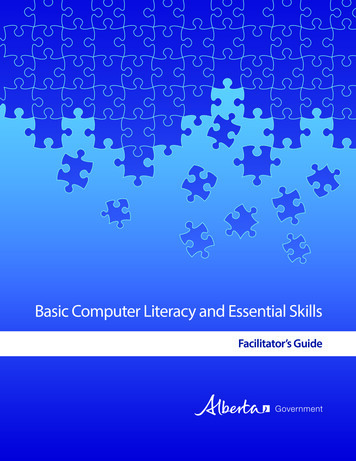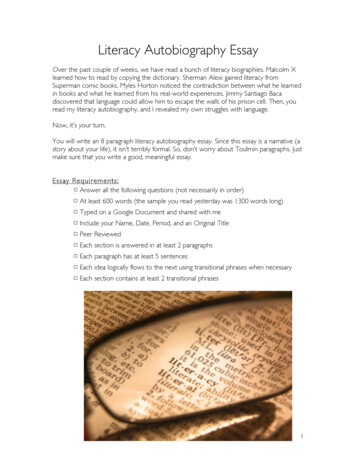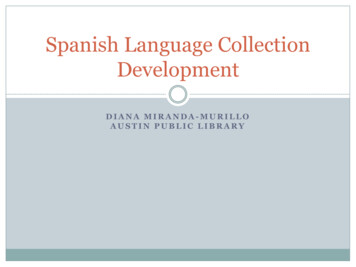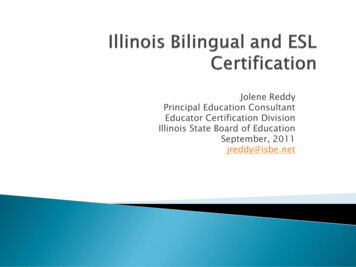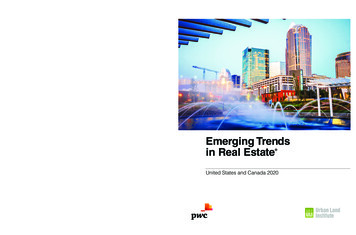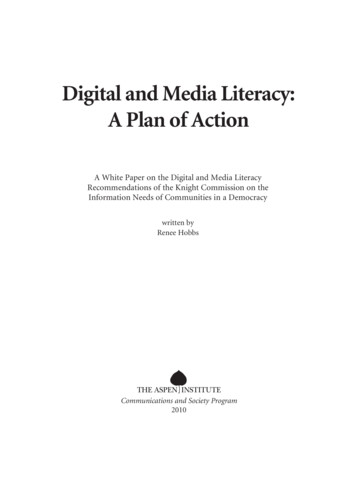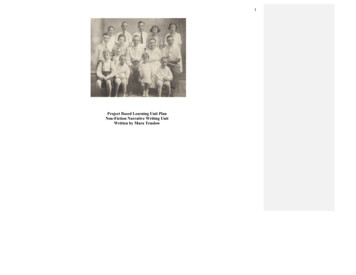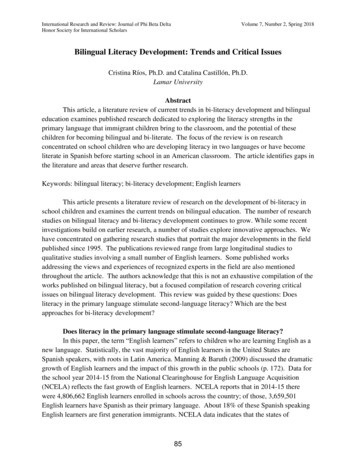
Transcription
International Research and Review: Journal of Phi Beta DeltaHonor Society for International ScholarsVolume 7, Number 2, Spring 2018Bilingual Literacy Development: Trends and Critical IssuesCristina Ríos, Ph.D. and Catalina Castillón, Ph.D.Lamar UniversityAbstractThis article, a literature review of current trends in bi-literacy development and bilingualeducation examines published research dedicated to exploring the literacy strengths in theprimary language that immigrant children bring to the classroom, and the potential of thesechildren for becoming bilingual and bi-literate. The focus of the review is on researchconcentrated on school children who are developing literacy in two languages or have becomeliterate in Spanish before starting school in an American classroom. The article identifies gaps inthe literature and areas that deserve further research.Keywords: bilingual literacy; bi-literacy development; English learnersThis article presents a literature review of research on the development of bi-literacy inschool children and examines the current trends on bilingual education. The number of researchstudies on bilingual literacy and bi-literacy development continues to grow. While some recentinvestigations build on earlier research, a number of studies explore innovative approaches. Wehave concentrated on gathering research studies that portrait the major developments in the fieldpublished since 1995. The publications reviewed range from large longitudinal studies toqualitative studies involving a small number of English learners. Some published worksaddressing the views and experiences of recognized experts in the field are also mentionedthroughout the article. The authors acknowledge that this is not an exhaustive compilation of theworks published on bilingual literacy, but a focused compilation of research covering criticalissues on bilingual literacy development. This review was guided by these questions: Doesliteracy in the primary language stimulate second-language literacy? Which are the bestapproaches for bi-literacy development?Does literacy in the primary language stimulate second-language literacy?In this paper, the term “English learners” refers to children who are learning English as anew language. Statistically, the vast majority of English learners in the United States areSpanish speakers, with roots in Latin America. Manning & Baruth (2009) discussed the dramaticgrowth of English learners and the impact of this growth in the public schools (p. 172). Data forthe school year 2014-15 from the National Clearinghouse for English Language Acquisition(NCELA) reflects the fast growth of English learners. NCELA reports that in 2014-15 therewere 4,806,662 English learners enrolled in schools across the country; of those, 3,659,501English learners have Spanish as their primary language. About 18% of these Spanish speakingEnglish learners are first generation immigrants. NCELA data indicates that the states of85
Bilingual Literacy Development: Trends and Critical IssuesRios and CastillónCalifornia, Texas, Florida, New York, and Illinois have the highest numbers of Spanish speakingEnglish learners (NCELA, 2017). The number of English learners whose primary language isSpanish continues to grow, and public school classrooms reflect this trend.Several studies have based their analysis on Krashen’s discussion of the major three rolesthat reading has in language improvement for English learners. Krashen (2005) indicates that“reading in the primary language is of great help in promoting second-language literacy.”Krashen points out that “free-reading in the second language makes a strong contribution toadvanced second-language development” and concludes that “free reading in the heritagelanguage appears to make a strong contribution to continued heritage-language development”(pp. 66-67).A number of studies have been published on the challenges faced by monolingual andemergent bilingual immigrant children in U.S. public schools and the approaches to teachlanguage and literacy to English learners (Gándara, Maxwell-Jolly, E. García, Asato, Gutierrez,Stritikus, & Curry, 2000; G. Garcia & Beltran, 2005; Thomas & Collier, 2011). The level of L1literacy of immigrant children varies depending on multiple factors such as age, years ofschooling in L1, quality of the schools, teachers, curriculum, reading comprehension, access tobooks, and home literacy. They have in common the knowledge of their primary language, andmany also possess both some academic skills in L1, and emergent literacy in the first language.Upon entering to school, these children have the potential to become bilingual and bi-literate.However, if the valuable emergent literacy these children possess is not nurtured, or if it issuppressed, they are in danger of both losing their literacy skills in L1 and having manydifficulties in acquiring literacy in the new language, L2.Wong-Fillmore & Valadez (2000) have stated, referring to English learners, that “in orderto become true bilinguals these children must hang onto and develop their knowledge of thenative language as they acquire English” (p.258, para. 2). These authors warn that “the learningof English all too often means the loss of the L1 For many of them, the price paid for learningEnglish is the mother tongue and their cultural identity” (p.259, para. 1). Cummins (2001) hasarrived at a similar conclusion, indicating that many parents do not realize “how quickly childrencan lose their ability to use their mother tongues” if the primary language is not supported in theschool and at home “children can lose their ability to communicate in their mother tongue within2-3 years of starting school” (p. 19, para. 2). While immigrant children with a well-establishedprimary language might not completely lose their oral competencies in L1, their academic skillsand literacy in L1 will certainly deteriorate if they stop reading and writing in their firstlanguage. Thomas & Collier (2011) indicate that research studies have demonstrated that“children whose first language use is stopped or slowed down before age 12 may experiencecognitive slowdown; whereas those whose first language is continuously developed through atleast age 12 have cognitive advantages” (p. 2, para. 3). In her study of emergent bi-literacy inyoung children, I. Reyes (2006) found that “when children have access to writing systems and tovarious literacy activities in both languages, they are more likely to become bi-literate” (p. 289,para. 1).86
Bilingual Literacy Development: Trends and Critical IssuesRios and CastillónThe primary language is a valuable resource for English learners’ development ofEnglish language abilities and literacy, as has been demonstrated by numerous research studies.When English learners have already acquired reading and writing skills in their first language(L1), they own a treasure of linguistic resources, cultural strengths, and academic foundations,which should support learning a second-language and the acquisition of English literacy(Cummins 2000, 2001, 2005; Collier & Thomas, 2007; Ernst-Slavit & Mulhern, 2003; Krashen,1997, 2004, 2005; Thomas & Collier, 1999, 2003; Wong-Fillmore & Valadez, 2000).The National Literacy Panel on Language-Minority Children and Youth concurred withthe research we have cited, arriving to the conclusion that literacy in the first-language iscorrelated to literacy development in English, stating that “there is clear evidence that tappinginto first-language literacy can confer advantages to English-language learners the researchindicates that instructional programs work when they provide opportunities for students todevelop proficiency in their first language” (August & Shanahan, 2006, p. 5, para. 2-5). Thisnational panel of 13 experts worked for 4 years examining hundreds of research studies, underrigorous criteria.Are schools meeting the needs of English learners?The literature suggests that the knowledge, skills, and abilities that immigrant childrenbring to school are in many cases overlooked or considered of no value by the teachers andschool administrators. In some instances, the baggage of prior knowledge and L1 literacy is seenas a liability and bilingualism is discouraged (Thomas & Collier, 1999; Cummins, 1996, 2000,2001; Griego-Jones & Fuller, 2003; Nieto, 2000; M. L. Reyes, 2000). Several recognizedauthors in the field narrate incidents in which a school teacher has advised Spanish-speakingparents to stop speaking Spanish to their child, so the child could better learn English. Theseteachers did not consider that if the parents did not speak to their children in Spanish, which wasthe only language they could use fluently, the parents’ communication with the child would bebroken. Several researchers have found that these situations continue to occur in our publicschools. Nieto & Bode (2010) stated that “ it is common practice in schools to try to convinceparents whose native language is other than English that they should speak only English withtheir children” (p. 403, para. 3). Nieto (2000) discusses the results of a countrywide survey,conducted by the National Association for Bilingual Education (NABE), which found that“serious disruptions of family relations occurred when young children learned English in schooland lost their native language” (p. 202, para 3, citing NABE News). When the home language isnot valued in the school, some children become reluctant to continue using their primarylanguage. As we have noted elsewhere, this language loss can have far-reaching negative effectsas the internal communication and relationships within the family are disrupted.An important factor to consider is the vast cultural heritage and values that are part of theidentities of immigrant children and their families, which on many occasions are disregarded byschools and teachers. Wong-Fillmore & Valadez (2000) have emphasized that these studentsand their families “have enormous cultural resources and talent to contribute to their adoptedsociety” (p.259, para. 1). While relating her childhood experiences, Nieto (2000) recalls the low87
Bilingual Literacy Development: Trends and Critical IssuesRios and Castillónexpectations of some of her teachers and how she encountered stereotypes that fostered thenotion that the Spanish language and culture were substandard. “I assumed, as many of my peersdid, that there was something wrong with us. We learned to feel ashamed of who we were, howwe spoke, what we ate, and everything else that was different about us” (p. 1, para. 3).According to E. Garcia (2002) “The assumptions a teacher makes about the student’s culture,whether right or wrong, may stereotype the student and thus preclude the flexible, realistic, andopen-minded teacher-student interaction needed for effective instruction” (p. 76, para. 1).Research shows that there are erroneous notions about literacy development ingrained inthe minds of some educators. English learners who can read with fluency in Spanish aresometimes discouraged by teachers of continuing reading in their primary language due tomistaken notions that reading in Spanish will prevent them from learning to read in English.Cummins (2005) discusses the existing misconceptions about language development and howthese mistaken views have impacted the teaching of reading and the instruction of Englishlearners. The authors of this article have encountered teachers totally convinced that Englishlearners should not read in their primary language. Parents of English learners have told us thatschool personnel have advised them not to let their children read anything in Spanish. One, forexample, recounted her experience with her daughter’s teacher as follows: “A Elenita le encantaleer, se pasaba la tarde leyendo. Le escondí los libros que trajimos de México, la maestra medijo que si sigue leyendo en español no va a aprender inglés.” (“Elenita loves reading; she usedto spend the whole afternoon reading. I had to hide the books we brought from Mexico; herteacher told me that if she continues reading in Spanish she will not learn English”). [Personalcommunication].Research studies indicate that conversations like the one above are, unfortunately,frequent. Parents of English learners want the best for their children: they want their children tolearn English, and in most cases they believe that the teacher is the expert in language learning.Teacher preparation programs thus have the responsibility to ensure that every teacher candidateunderstands how languages are learned. Teachers need to be aware that reading skills transferacross languages. Sometimes schools tend to focus on remediation of English learners andassess them from a “deficit perspective” instead of valuing the richness of their primarylanguage, cultural strengths, and the knowledge they have previously acquired, forgetting that“these students often arrive with a wealth of life experiences, including age-appropriate thinking,richly expressed in primary language” (Thomas & Collier, 1999, p. 46, para. 3). SolteroGonzález, Escamilla & Hopewell (2012) propose a holistic bilingual approach in order toproperly assess the writing skills of emerging bilingual children. The authors point out the needfor modifying teachers’ perceptions about bi-literacy.Curriculum & Instruction that Supports Bi-literacyThere is abundant research indicating the positive effects of the continuous developmentof the primary languages of English learners as they are in the process of learning English as anew language (Collier & Thomas, 2007; Goldenberg, 2008, 2013; Krashen, 1997; I. Reyes,88
Bilingual Literacy Development: Trends and Critical IssuesRios and Castillón2006). Krashen (1997) asserts that when English learners receive quality education in L1,schools are providing these children with content knowledge and literacy skills. “The knowledgethat children get through their first language helps make the English they hear and read morecomprehensible. Literacy developed in the primary language transfers to the second language”(Krashen, 1997, p. 2, para 1). Other researchers arrived to similar conclusions; Collier andThomas (2007) have pointed out that, for English learners in the primary grades, the linguisticgains in the first language transfer to the second language and the content knowledge acquiredthrough L1 becomes a knowledge base that will support academic development in L2. Collierand Thomas stress that “When schooling is provided in both L1 and L2, both languages are thevehicle for strong cognitive and academic development” (p. 341, para. 1). English learners canuse their literacy skills in the Spanish language to understand features of the English language.Cummins (2005) asserts that there are “many possibilities for cross-linguistic languageexploration” and indicates that “The Latin or Greek origins of academic vocabulary in Englishalso means that there are many cognates between this vocabulary and the vocabulary of Spanishand other Romance languages” (p.24, para. 4). Cummins refers to Coxhead (2000) who hadrecommended the study of prefixes, suffixes and stems for learning academic vocabulary, giventhat more than 82% of academic words used in English come from the Greek or Latin (p.24).The academic repertoire of words that immigrant English learners might already know and beable to recognize is an important source for expanding their content knowledge and learningEnglish. Research demonstrates the importance of helping students make cross-languageconnections (Soltero-González, Sparrow, Butvilofsky, Escamilla, & Hopewell, 2016; Sparrow,Butvilofsky, Escamilla, Hopewell & Tolento, 2014).Wong-Fillmore & Valadez (2000) believe that bilingual education “offers children achance to become bilingual without giving up their cultural identities and to enjoy the socialand cognitive benefits that bilingualism offers to individuals” (p. 258, para. 2). Cummins (2001)concurs on the advantages of bilingualism stating: “Bilingualism has positive effects onchildren’s linguistic and educational development” (p. 17, para 4). Bilingualism is an asset andshould be valued by teachers and schools. Proficiency in the primary language is a key factorthat supports the development of literacy skills in a new language. English learners should beencouraged to build upon the skills they have in their primary language. If these English learnerskeep increasing their primary language literacy as they develop academic language proficiencyin English, they have the possibility of becoming bilingual and bi-literate (Dworin, 2003; G.Garcia & Beltran, 2005; Hopewell & Escamilla, 2014).When a child enjoys reading and is engaged in voluntary and self-selected free reading,the child has a valuable resource for academic achievement. Immigrant children who are avidreaders have in their books a link to their roots, culture, family and friends left behind. Literaturein the primary language should be encouraged and facilitated for these children. According toKrashen (1997), reading in one language will support learning to read in the second language“Children who arrive with a good education in their primary language have already gained two89
Bilingual Literacy Development: Trends and Critical IssuesRios and Castillónof the three objectives of a good bilingual education program -- literacy and subject matterknowledge” (p. 3, para 2).G. Garcia & Beltran (2005) point out that the primary language “permits children to usetheir full language repertoire to help them acquire a second language” and there is evidence that“conceptual understanding is greatly enhanced when supported by the child’s primary language;this language link to the home provides a comfort zone” that can help students achieve success(p. 215, para. 3).Many English learners will become “Sequential Bilinguals,” as defined by Trumbull &Pacheco (2005): “Sequential Bilingual - A person who has learned a second language after thefirst language is established” (p.71, para. 1). The ideal would be that they also become biliterate. Researchers agree that: “if children continue to have access to and opportunities tofunction in both languages and writing systems, they will be more likely to maintain andcontinue to develop their bilingualism and bi-literacy” (I. Reyes, 2006, p. 289, para. 1).Nevertheless, as Krashen (1997) determined, English learners do not always have access toreading and educational materials in both languages. In many instances, the school environmentand learning resources available exclude the culture and language of the child’s home. Englishlearners who learn to read in both L1 and L2 develop important skills that provide thefoundations of academic success. Research supports the importance of bilingual academiclanguage development for these children (Cummins, 2000, 2001, 2005; Hopewell & Escamilla,2014).When English learners have the opportunity of developing literacy skills in bothlanguages their academic potential increases. If a child has developed literacy skills in Spanishand is involved in self-selected reading of newspapers, magazines, comic books, fiction, storiesand books in Spanish; these reading activities should not be discouraged (Krashen, 1997, 2004;Krashen & Mason, 2015). The enjoyment of reading in one language will transfer to the newlanguage. Exposure to interesting reading material in both languages supports bilingual literacydevelopment. In other words, literacy activities in the primary language will support learningEnglish and the development of academic language skills when English learners start school inthe United States.Ernst-Slavit & Mulhern (2003) support the use of bilingual books for fostering bilingualliteracy. Bilingual books are particularly useful for English learners and sequential bilingualchildren. The availability of bilingual resources and bilingual books continues to increase.There are a number of publishers dedicated to produce culturally relevant bilingual literature forchildren that genuinely portray the Latino culture. There is a comprehensive range of bilingualliterature for different age levels and about countless topics. As English learners gain literacyskills in their new language, they should be able to enjoy reading books in both their first andsecond language. English learners should have access to a variety of high quality and interestingliterature in both L1 and L2; if they find pleasure in reading, they will have more chances ofsucceeding in school. Reading is central to increasing school achievement and test scores inevery subject. Krashen (1997) emphasizes the importance of the availability of literary resources90
Bilingual Literacy Development: Trends and Critical IssuesRios and Castillónin the school and at home. He has stated that the main problem with bilingual education “is theabsence of books--in both the first and second languages -- in the lives of students in theseprograms” (Krashen, 1997, p. 4, para 5). The availability of books in L1, L2, and bilingualbooks enables voluntary reading. “Free voluntary reading can help all components of bilingualeducation: It can be a source of comprehensible input in English or a means for developingknowledge and literacy through the first language, and for continuing first languagedevelopment” (Krashen, 1997, p. 5 para. 1).Cummins (2001) has highlighted the benefits of dual language acquisition indicating thatelementary school children who develop literacy in more than one language obtain “deeperunderstanding of language and how to use it effectively. They have more practice in processinglanguage, especially when they develop literacy in both, and they are able to compare andcontrast the ways in which their two languages organize reality” (Cummins, 2001, p. 17, para. 5).Other experts agree: “proficient bilinguals (who develop written as well as oral proficiency inboth languages) outscore monolinguals on many types of measures-especially in measures ofcreativity and problem-solving” (Thomas & Collier, 2011, p. 2, para. 3).Models of Instruction for Bi-literacy DevelopmentA wide range of instructional models and strategies there have been implemented toinstruct English learners and this is reflected in the research studies reviewed. Among thepedagogical methodologies with documented success are the dual language bilingual approachesand the paired literacy instructional models. In a dual language program, English learners aretaught in academic content in both L1 and L2. Dual language programs can be implementedeither as a one-way or a two-way program, depending on the demographics. In the one-waymodel, most of the students are English learners whereas in the two-way model, native speakersof Spanish and native speakers of English are instructed together in both languages. Most of thedual language programs use Spanish and English, given that the majority of English learners inthe U.S. have Spanish as their L1 language (NCELA, 2017), but there are dual languageprograms that pair English with another language, such as Vietnamese , Mandarin, Arabic,French, or others. In classrooms with multiple languages dual language programs are notfeasible. This review is focused on bilingual Spanish-English programs.Thomas & Collier (2011) determined that dual language programs are effective forEnglish learners and that these programs are able to close the achievement gap of Englishlearners faster than other instructional approaches: “current strategies that close the gap in theshortest amount of time possible are found in dual language programs, in which English learnersare receiving the curriculum at least half of the instructional time through their mother tongueand the other half in English” (p. 1, para. 3). School children who are literate in Spanish whenentering an American school will benefit from a dual language program; they can continuedeveloping their primary language in school, and use their first language as a foundation forbecoming literate in English. Sleeter & Grant (2009) assert that dual language programs91
Bilingual Literacy Development: Trends and Critical IssuesRios and Castillón“promote full academic competence in two languages among both immigrant and native-Englishspeaking students” (p. 29, para 2).Dual language programs give students the opportunity to become bilingual, bi-literate,and develop bi-cultural competences. Numerous research studies demonstrate that dual languageprograms are ideal for immigrant elementary school children who have achieved basic literacy inSpanish and have learned to read and write in their primary language before entering school inthe United States. These children can continue acquiring content knowledge in their primarylanguage and reading for academic purposes and for pleasure while learning English as a newlanguage (Alanis & Rodriguez, 2008; Collier & Thomas, 2007; Kibler, Salerno, & Hardigree,2014; Lindholm-Leary, 2012; Thomas & Collier, 2003).Research by Thomas & Collier (2003) reveals that in a dual language classroom “Englishlearners have an opportunity to make faster-than-average progress on grade-level instruction thatis not watered down” (p. 61, para. 2). Thomas & Collier have studied the effects of duallanguage programs for years and have asserted that English learners are better served by the dualbilingual education model. Research has demonstrated that in well implemented dual languageprograms children can reach high academic achievement in both languages (Thomas & Collier,1999, pp. 46- 47).Several research studies have examined the effectiveness of paired literacy models whichdeliver literacy instruction in Spanish and English; with an emphasis in the importance of crosslanguage connections and high quality literacy instruction in both languages. Results oflongitudinal research studies using the paired literacy model “Literacy Squared” support thebenefits of simultaneous literacy development, reading and writing, in both languages (SolteroGonzález, et al., 2016; Sparrow, et al., 2014). The benefits of metalinguistic awareness havedemonstrated in a number of research studies. Beeman & Urow (2013, 2017) have studied theimplementation of “The Bridge” approach in which the teacher helps students recognize thedifferences and similarities between L1 and L2 and to understand the metalinguistic connections.Several studies denote the need of appropriate bilingual assessment for English learners.Researchers indicate that the development of bilingual assessment instruments is crucial in theclassroom and for further research purposes (Soltero-González, et al., 2012; Sparrow, et al.,2014).The National Literacy Panel on Language-Minority Children and Youth, after a rigorousresearch examination, found that “studies that compare bilingual instruction with English-onlyinstruction demonstrate that language-minority students instructed in their native language aswell as in English perform better, on average, on measures of English reading proficiency thanlanguage-minority students instructed only in English” (August & Shanahan, 2006, p. 5, para. 5).Following the publication of the findings of the National Literacy Panel, experts in the fieldanalyzed the panel’s conclusions and recommendations. Goldenberg (2008) remarked that thenational panel was “the latest of five meta-analyses that reached the same conclusion: learning toread in the home language promotes reading achievement in the second language” (p. 15, para.2). Other researchers questioned if educational policies that prevent English learners to become92
Bilingual Literacy Development: Trends and Critical IssuesRios and Castillónbi-literate would change. “Given this knowledge, will federal/state/local policies encourage theimplementation and study of multiple approaches to the education of language minoritystudents? Or will we continue to see the current trend toward policy initiatives that privilege andmandate monolingual approaches?” were some of the questions raised by Escamilla, (2009) inher review of the findings of the national panel (p. 451, para. 3). Experts in the field havepointed out that the research findings were conclusive and that policy and practice should beguided by the research evidence, but research demonstrate that this is not always the case.Goldenberg (2008) expressed the concern that despite the conclusive results of five differentmeta-analyses, educational policies in several states disregard the scientific evidence. The use ofthe first language continues to be avoided in many classrooms and English learners do notalways receive the instructional modifications needed.Trends and Further StudyThe literature reviewed demonstrates the many complexities and paradigms in bilingualeducation. Researchers in the field continue to seek better approaches for bi-literacydevelopment, the research reviewed exhibits some consistent findings on “best practices” inbilingual education. A major premise found in the literature is that the transfer of literacy skillsfrom one language to another language occurs, so that literacy in both L1 and L2 should besupported and encouraged. It is widely recognized in the literature that bilingual literacy is anadvantage and that there are many life-long benefits in becoming bilingual and bi-literate. Abicultural curriculum that supports bilingualism and bi-literacy requires culturally competentteachers able to help children make cross-language connections; these teachers must understandbi-literacy development and bilingual assessment (Collier & Thomas, 2007; Cortina, Makar, &Mount-Cors, 2015; Kibler, Salerno, & Hardigree, 2014; Soltero-González, et al., 2016; Sparrow,et al., 2014; Thomas & Collier, 1999, 2003).Our review elucidates that the study of bi-literacy development is an evolving field.There is a growing body of literature concerned with the implementation of bilingualpedagogical approaches that provide conn
primary language that immigrant children bring to the classroom, and the potential of these children for becoming bilingual and bi-literate. The focus of the review is on research concentrated on school children who are developing literacy in two languages or have become literate in Spanish


